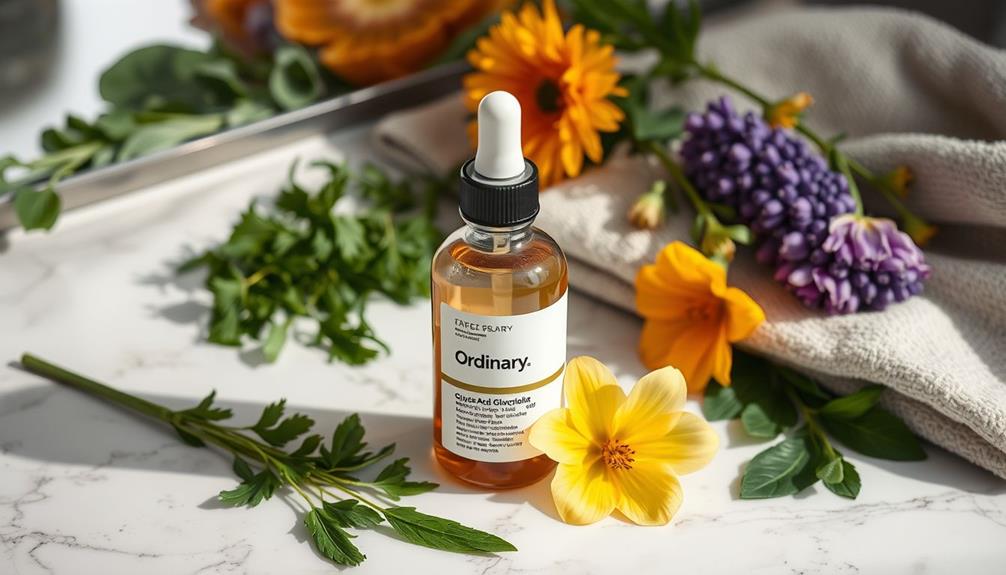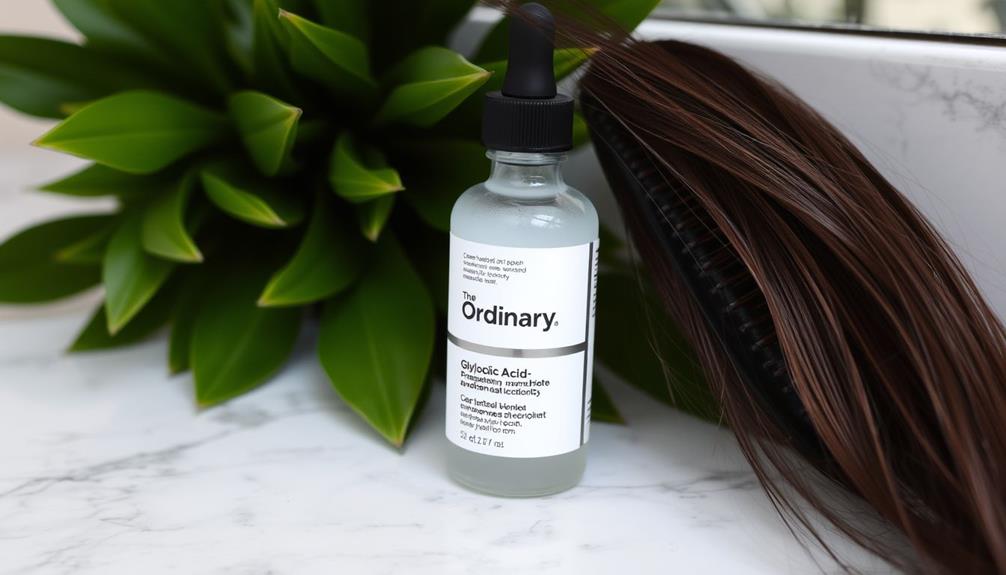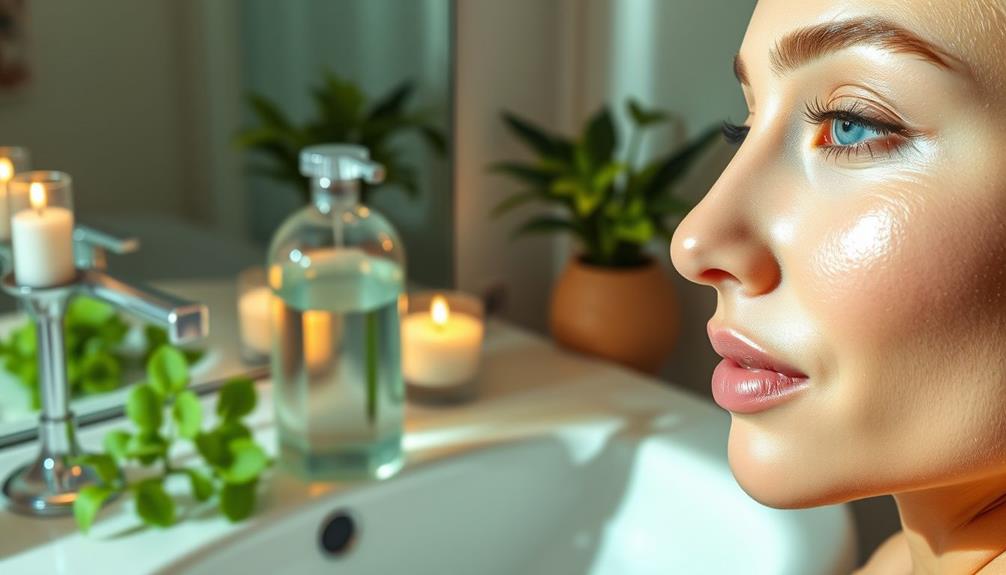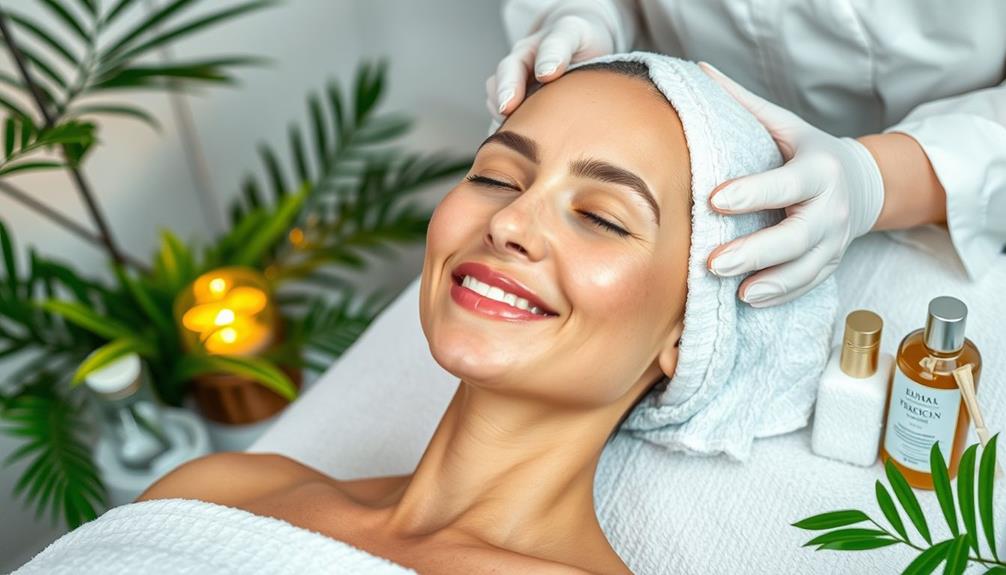The Ordinary’s Glycolic Acid can enhance the health of your hair by promoting a healthier scalp. It works by exfoliating dead skin cells and excess oil while also maintaining moisture, ultimately helping to reduce breakage. Additionally, its antimicrobial properties target both dandruff and scalp acne. It is most suitable for oily or flaky scalps and should be used sparingly, ideally once or twice a week. If you have sensitive skin or color-treated hair, it is important to be cautious as overuse can cause irritation or weaken your hair strands. For more information on application techniques and product recommendations, you may want to explore further options available.
Key Takeaways
- Glycolic acid exfoliates the scalp, removing dead skin cells and reducing oiliness, promoting a healthier hair growth environment.
- It maintains moisture levels in the scalp, helping to prevent hair breakage and promoting overall hair health.
- With antimicrobial properties, glycolic acid combats scalp issues like dandruff and acne, improving scalp conditions.
- Recommended usage is once or twice a week to avoid irritation, especially for sensitive scalps.
Benefits of Glycolic Acid for Hair

Benefits of Glycolic Acid for Hair
Glycolic acid offers numerous benefits for your hair by exfoliating the scalp, promoting a healthier environment for hair growth. When you incorporate glycolic acid for hair into your routine, you'll notice that it effectively lifts dead skin cells and excess sebum, reducing oiliness and product buildup. This leads to cleaner, fresher hair and improved scalp health.
Additionally, combining glycolic acid with essential oils for hair growth can further enhance stimulation of hair follicles and nourish your strands.
One of the most significant benefits of glycolic acid is its ability to maintain moisture levels in the scalp. This helps prevent hair breakage, ensuring your locks remain strong and resilient. Plus, its antimicrobial properties assist in combating scalp issues like acne and dandruff, contributing to a clearer, healthier scalp overall.
Regularly using glycolic acid can also promote cellular renewal, which may slow down the aging process of your scalp. By fostering a vibrant environment for hair follicles, you're setting the stage for ideal hair growth.
Hair Type Considerations

When considering glycolic acid for hair care, it's important to assess your specific hair type and scalp condition to guarantee best results.
Glycolic acid can work wonders for those with oily or flaky scalps, as it effectively exfoliates dead skin cells and helps reduce excess sebum. For individuals seeking effective solutions for their scalp health, exploring hair treatments for damaged hair can provide additional benefits. If your scalp tends to be oily, incorporating glycolic acid hair products into your routine may lead to improved scalp and hair health.
However, if you have sensitive skin or any open sores, tread carefully. Glycolic acid can cause irritation or adverse reactions, so it's best to avoid it in these cases.
Additionally, using glycolic acid too frequently can weaken hair strands over time, potentially leading to hair loss. For peak results, consider using glycolic acid products once or twice a week, gradually adjusting based on your scalp's tolerance.
Keep in mind that glycolic acid isn't ideal for color-treated or chemically processed hair, including those that have been straightened or permed. Always evaluate your hair's needs and condition before diving into glycolic acid treatments to ensure you're making the best choice for your hair care.
How to Use Glycolic Acid

To effectively use glycolic acid for your hair, apply it to your scalp once or twice a week to avoid over-exfoliation and irritation.
Start by selecting a product that suits your needs, whether it's a scrub, toner, or serum. Always perform a patch test first to gauge your scalp's sensitivity.
Additionally, maintaining a healthy indoor environment can enhance the overall effectiveness of your hair care routine, especially if you use an air purifier to reduce allergens and pollutants in your surroundings.
When you're ready, apply the glycolic acid at night to reduce sun sensitivity. Massage it into your scalp, ensuring even coverage, and leave it on for about 10 to 30 minutes. This duration allows your scalp to absorb the benefits effectively.
After the recommended time, rinse thoroughly to remove any residue.
Pay close attention to how your scalp reacts after each application. If you notice any redness or irritation, consider reducing frequency or switching to a milder formulation.
Remember, everyone's scalp is different, so adjusting your routine based on personal experience is essential.
Following these steps will help you harness the exfoliating power of glycolic acid, promoting healthier hair and a balanced scalp. Regular use can lead to improved hair texture and overall scalp health, making it a worthwhile addition to your hair care regimen.
Expert Recommendations

Consulting with a dermatologist is vital before adding glycolic acid to your hair care routine, as it helps confirm the treatment aligns with your specific scalp needs.
Expert recommendations emphasize starting with a low concentration of glycolic acid and gradually increasing usage. This approach allows you to monitor your scalp's tolerance and avoid irritation.
Additionally, it's important to confirm your hair and scalp are in good health prior to introducing new treatments, especially considering potential cat health and nutrition factors that can influence skin sensitivity.
Dr. Usman Qureshi advises using glycolic acid as a rinse-off treatment no more than once a week to minimize the risk of scalp irritation.
Additionally, professionals highlight the importance of avoiding the concurrent use of glycolic acid with other exfoliating agents, especially vitamin C. This precaution helps prevent adverse reactions that could compromise your scalp health.
Monitoring how your scalp reacts after using glycolic acid is vital. Adjusting the application frequency based on your scalp's response will help you balance the benefits of glycolic acid with any potential side effects.
By following these expert recommendations, you can safely integrate glycolic acid into your hair care routine while promoting overall scalp health.
Safety and Precautions

Using glycolic acid safely requires you to limit its application to no more than once or twice a week to protect your scalp barrier.
Incorporating practices like gentle yoga stretches can also help reduce tension in the body, promoting overall scalp health. Overusing it can lead to irritation, compromising your scalp's health. If you notice any signs of irritation, like redness or itching, discontinue use immediately.
Before trying glycolic acid, perform a patch test on a small area of your scalp. This step is vital to guarantee that your skin can tolerate the product without adverse reactions.
Start with a low concentration, especially if you have sensitive skin, as this helps minimize the risk of irritation. It's important to be cautious if you've recently had scalp treatments, like coloring or chemical straightening, as glycolic acid may not be suitable in these cases.
Always prioritize safety by listening to your body and adjusting usage as needed. If you encounter any discomfort at any point, it's best to stop using the product.
Product Overview

The Hair & Scalp Collection from The Ordinary offers an extensive range of products that harness the benefits of glycolic acid to improve scalp health and address common issues like dandruff and excess oil.
Incorporating mindful practices into your hair care routine can enhance your overall scalp health, much like the benefits of stress management techniques for overall well-being.
Priced at $35.80, this collection includes the Glycolic Acid 7% Exfoliating Toner, Multi-Peptide Serum, shampoo, conditioner, and various treatment products, all designed to promote peak hair health.
The Glycolic Acid 7% Exfoliating Toner specifically targets scalp concerns by exfoliating and renewing skin texture, making it suitable for those dealing with oily or flaky scalps.
This collection caters to diverse hair types, ensuring everyone can find a suitable solution that enhances their scalp and hair health.
Plus, you can enjoy a 10% discount at checkout, along with free shipping on orders over $25, making it a budget-friendly choice.
With a 365-day return policy, you can confidently try these products risk-free.
Key Ingredients

Key ingredients in The Ordinary's Hair & Scalp Collection work synergistically to enhance scalp health and promote vibrant hair. A standout is Glycolic Acid, an alpha hydroxy acid that exfoliates the scalp, removing dead skin cells to create a healthier environment for hair growth. This formulation also includes multi-peptide serum components that support hair density.
To keep your scalp hydrated and balanced, aloe vera is included for its soothing benefits, while tea tree oil fights scalp acne and dandruff with its antimicrobial properties. Jojoba oil mimics natural scalp oils, enhancing moisture retention and overall scalp health. Finally, keratin strengthens hair structure, reducing breakage and ensuring your hair remains strong.
Here's a quick overview of the key ingredients:
| Ingredient | Benefits | Function |
|---|---|---|
| Glycolic Acid | Exfoliates dead skin cells | Improves scalp health |
| Aloe Vera | Hydrates and soothes | Maintains moisture balance |
| Tea Tree Oil | Antimicrobial properties | Reduces acne and dandruff |
| Jojoba Oil | Mimics natural oils | Enhances moisture retention |
User Experiences

How have users reacted to The Ordinary's Glycolic Acid for their hair and scalp health?
Many TikTok users have shared glowing user experiences, highlighting significant improvements in both scalp health and overall hair quality. For instance, user @phithegoldenskin showcased their transformation, illustrating how the product revitalized their scalp and enhanced hair shine through engaging videos.
A survey revealed that 85% of users reported improved scalp health, while an impressive 90% noted increased hair softness and shine after incorporating glycolic acid into their routine.
The feedback consistently emphasizes the product's ability to reduce scalp flakiness and dandruff, making it a go-to solution for those struggling with these common issues.
Users appreciate how The Ordinary's Glycolic Acid not only promotes a healthier scalp but also reduces hair breakage over time, contributing to a more vibrant look.
This community-driven sharing of experiences has heightened awareness of glycolic acid's benefits for hair health, encouraging others to try it.
If you're considering a hair care change, these user experiences suggest that glycolic acid might just be the solution you need for revitalized, shiny hair.
Trend Overview

Recently, numerous TikTok users have embraced the trend of using The Ordinary's Glycolic Acid for boosting hair health, originally intended for skin care. This hair hack has gone viral, with users sharing their experiences of reduced dandruff and hair breakage. Many document their transformations over a month, showcasing stronger and shinier locks.
The appeal of Glycolic Acid lies in its small molecule size, which allows it to penetrate deeply into your hair and scalp. This effective cleansing action helps lift excess sebum and product buildup, making it especially beneficial for those with an oily scalp. TikTok videos highlight these positive results, encouraging more people to give it a try.
However, while the trend seems promising, it's essential to approach it with caution. Community recommendations suggest using Glycolic Acid no more than once a week to avoid potential irritation. As you consider incorporating this trend into your hair care routine, remember to monitor how your scalp and hair respond to the treatment.
With careful use, you might just find that this unexpected hair hack can lead to healthier, more vibrant hair.
Frequently Asked Questions
Does the Ordinary Glycolic Acid Help Hair?
Yes, The Ordinary Glycolic Acid can help your hair by exfoliating the scalp, reducing dandruff, and improving overall scalp health. Regular use enhances hair texture and manageability, making it beneficial for oily or flaky scalps.
Does Glycolic Acid Repair Hair?
Does glycolic acid really repair hair? While it doesn't directly repair strands, it promotes a healthier scalp, reduces buildup, and encourages growth. Just remember to use it sparingly to avoid potential damage.
How Long Does It Take for Glycolic Acid to Work on Hair?
It typically takes about 4 to 6 weeks of regular use for glycolic acid to show noticeable improvements in your hair and scalp health, enhancing texture, softness, and shine while reducing dandruff and flakiness.
Does Glycolic Acid Make Hair Grow?
Glycolic acid doesn't directly make hair grow, but it improves scalp health by exfoliating and reducing sebum. This better environment may support hair follicles and enhance overall hair quality, leading to stronger and shinier hair.
Conclusion
So, can glycolic acid really make your hair fabulous? Well, if you're ready to treat your strands like a science experiment and embrace the possibility of a tingle, then go for it!
Just remember, while you're busy transforming your locks into a shiny masterpiece, don't forget your hair's basic needs—like moisture and love.
After all, even in the world of beauty, sometimes the simplest conditioner might just be the true hero, not the acid with a fancy name!










